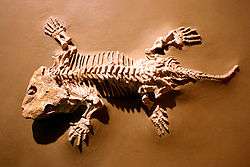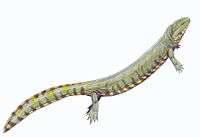Seymouriamorpha
Seymouriamorpha were a small but widespread group of limbed vertebrates (tetrapods). They have long been considered reptiliomorphs, and most paleontologists may still accept this point of view, but some analyses suggest that seymouriamorphs are stem-tetrapods (not more closely related to Amniota than to Lissamphibia).[1] Many seymouriamorphs were terrestrial or semi-aquatic. However, aquatic larvae bearing external gills and grooves from the lateral line system have been found, making them unquestionably amphibians. The adults were terrestrial. They ranged from lizard-sized creatures (30 centimeters) to crocodile-sized 150 centimeter long animals. They were reptile-like. If seymouriamorphs are reptiliomorphs, they were the distant relatives of amniotes. Seymouriamorphs form into three main groups, Kotlassiidae, Discosauriscidae, and Seymouriidae, a group that includes the best known genus, Seymouria. The last seymouriamorph became extinct by the end of Permian.[2]
Taxonomy
Cladogram based on Ruta, Jeffery, & Coates (2003):[4]
Cladogram based on Klembara (2009) & Klembara (2010):[5][6]
Gallery
References
- ↑ Laurin, Michel (2010). How Vertebrates Left the Water. Berkeley: University of California Press. ISBN 978-0-520-26647-6.
- ↑ Bulanov VV (2003). "Evolution and systematics of seymouriamorph parareptiles". Paleontological Journal 37 (Supplement 1): 1–105.
- ↑ Olson, E. C. (1951). "Fauna of upper Vale and Choza: 1-5". Fieldiana Geology 10 (11): 89–128. doi:10.5962/bhl.title.3264.
- ↑ Ruta, M.; Jeffery, J. E.; Coates, M. I. (2003). "A supertree of early tetrapods". Proceedings of the Royal Society B 270 (1532): 2507–16. doi:10.1098/rspb.2003.2524. PMC 1691537. PMID 14667343.
- ↑ Klembara, Jozef (2009). "The skeletal anatomy and relationships of a new discosauriscid seymouriamorph from the lower Permian of Moravia (Czech Republic)". Annals of Carnegie Museum 77 (4): 451–483. doi:10.2992/0097-4463-77.4.451.
- ↑ Klembara, Jozef (2011). "The cranial anatomy, ontogeny, and relationships of Karpinskiosaurus secundus (Amalitzky) (Seymouriamorpha, Karpinskiosauridae) from the Upper Permian of European Russia". Zoological Journal of the Linnean Society 161 (1): 184–212. doi:10.1111/j.1096-3642.2009.00629.x.
External links




